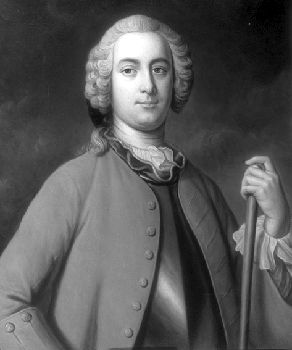
Edward Cornwallis
In 1749, British military officer Edward Cornwallis was appointed governor of Nova Scotia and sent to found the settlement of Halifax. He established the new capital to protect British settlers from the French fort at Louisbourg and to strengthen Britain’s hold on Nova Scotia.
Cornwallis soon became entangled in fighting with members of the Mi’kmaq First Nation, who also claimed the land on which he established Halifax. After Mi’kmaq warriors attacked and killed British settlers in the summer of 1749, Cornwallis issued a proclamation promising a cash bounty for every Mi’kmaq person taken or killed in the province. It later became known as the scalping proclamation.
Cornwallis Name Fades, Returns
Cornwallis faded from Nova Scotia history until 1899, when James S. Macdonald delivered a paper about his life to the Nova Scotia Historical Society on the 150th anniversary of the city’s founding. In 1924, Halifax marked 175 years since Cornwallis had established the city, by re-enacting his landing in a replica of the Sphinx, the ship he arrived on. Newspaper accounts of the anniversary say that 10,000 people watched as re-enactors dressed as “Indians” welcomed him ashore.
In the July 1927 edition of the Dalhousie Review, Dalhousie University professor Archibald MacMechan argued that “men of English blood all the world over are accustomed to feel and give voice to a just pride in the achievements of their race, as a colonizing power,” and that Cornwallis deserved more respect in Halifax for that reason. MacMechan described the Mi’kmaq as “wild Indians” whose “cruelty and cunning were a proverb, continually to guard against.”
In October 1929, Nova Scotia Premier Edgar Rhodes wrote that he was “delighted to learn that a movement is on foot here to have erected a statue of the Hon. Edward Cornwallis, and Massey Rhind, the sculptor, has been engaged.” The statue would be placed in the centre of a park in front of the new Canadian National Railways station in the south end of the city. It would pay tribute to Cornwallis and also attract tourists, wrote the Cornwallis Memorial Committee. The memorial committee noted that at the time of Halifax’s founding, “the Indians opposed the ominous big camp of white men.”
Statue Built
Rhind’s statue arrived in May 1931, and on 22 June the city held a grand dedication ceremony in Cornwallis Park. The $20,000 sculpture was paid for by Canadian National Railways, the province of Nova Scotia, and the City of Halifax.

In 1974, Cornwallis was declared a national historic person by the federal government, based on the recommendation of the Historic Sites and Monuments Board of Canada. In 1985 the Monuments Board installed a plaque on the statue’s plinth, listing Cornwallis’s birth in 1713 and death in 1776, accompanied by this inscription:
“After an active career in the British army, Cornwallis, the founder of Halifax, was appointed governor and captain general of Nova Scotia in 1749. Ordered in that year to establish a fortified settlement as a buffer between New England and New France and as a counterpoise to the Fortress of Louisbourg, he arrived in Chebucto Bay with a large body of settlers and proceeded to clear land and lay out the town of Halifax. He returned to England in 1752 leaving behind the beginnings of a thriving town. He later resumed his army career and in 1762 was appointed governor of Gibraltar.”
In a 2013 paper presented to the Nova Scotia Historical Society, Saint Mary’s University professor John Reid said the “historical memory of Cornwallis that was symbolized by the statue … was governed not by history, but by a potent mix of imperialism, a racially-charged triumphalism based on the savagery-civilization binary, state promotion, and an economic agenda.”
Controversy Emerges
The public conception of Edward Cornwallis was challenged in 1993, when Mi’kmaq elder Daniel Paul published We Were Not the Savages, a Mi’kmaq perspective on Nova Scotian history. He described Cornwallis’s hostile actions toward the Mi’kmaq as “genocide,” arguing that it “aptly describes the barbaric behaviour of the British in colonial Nova Scotia.” Paul wrote that Cornwallis’s 1749 “scalping proclamation” showed he “was well endowed with a heartless cruelty.”
Paul urged that places named after Cornwallis should be renamed, and called for the statue to come down. Groups like the Halifax Military Heritage Preservation Society defended Cornwallis’s legacy, saying his actions “were lawful at the time and he had full authority to issue them,” and that claims of genocide “do not hold up under scrutiny.”

In 2014, Halifax city council began upgrading Cornwallis Park, reviving the statue debate in the process. In 2015, Allan MacMaster, the Member of the Legislative Assembly (MLA) for Inverness, also called for the statue to come down. Premier Stephen McNeil asked Halifax to consider moving the statue to another location.
In 2016, Halifax council voted against discussing how Cornwallis’s name was used on municipal properties, including the park and statue. In April 2017, council voted again on the issue, this time agreeing to establish an expert panel to advise how Cornwallis should be commemorated.
On 1 July 2017, an Indigenous-led Canada Day protest of Cornwallis at the statue was interrupted by a group called the Proud Boys, who said the protest was “disrespecting” Cornwallis. These particular Proud Boys were off-duty members of the Canadian Armed Forces and were placed on probation because of their Canada Day actions.
In January 2018, Halifax council voted 12-4 to take down the statue and place it in temporary storage, while it considers the statue's long-term future.

 Share on Facebook
Share on Facebook Share on X
Share on X Share by Email
Share by Email Share on Google Classroom
Share on Google Classroom